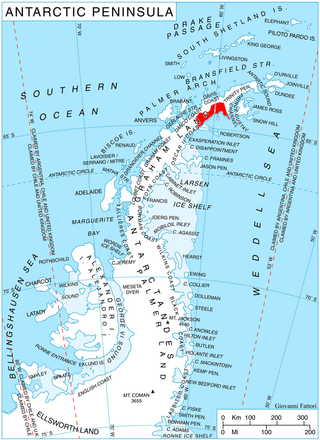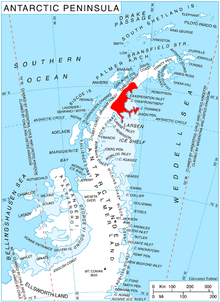
Alexandra Mountains is a group of low, separated mountains in the north portion of Edward VII Peninsula, just southwest of Sulzberger Bay in Marie Byrd Land, Antarctica. Discovered in January–February 1902 by the British National Antarctic Expedition during an exploratory cruise of the Discovery along the Ross Ice Shelf. Named for Alexandra, then Queen of the United Kingdom.
The Neptune Range is a mountain range, 112 km (70 mi) long, lying WSW of Forrestal Range in the central part of the Pensacola Mountains in Antarctica. The range is composed of Washington Escarpment with its associated ridges, valleys and peaks, the Iroquois Plateau, and the Schmidt and Williams Hills. It was discovered and photographed on 13 January 1956 on a US Navy transcontinental plane flight from McMurdo Sound to Weddell Sea and return.

James Ross Island is a large island off the southeast side and near the northeastern extremity of the Antarctic Peninsula, from which it is separated by Prince Gustav Channel. Rising to 1,630 metres (5,350 ft), it is irregularly shaped and extends 64 km in a north–south direction. It was charted in October 1903 by the Swedish Antarctic Expedition under Otto Nordenskiöld, who named it for Sir James Clark Ross, the leader of a British expedition to this area in 1842 that discovered and roughly charted a number of points along the eastern side of the island. The style, "James" Ross Island is used to avoid confusion with the more widely known Ross Island in McMurdo Sound.

The Prince Charles Mountains are a major group of mountains in Mac. Robertson Land in Antarctica, including the Athos Range, the Porthos Range, and the Aramis Range. The highest peak is Mount Menzies, with a height of 3,228 m (10,591 ft). Other prominent peaks are Mount Izabelle and Mount Stinear. These mountains, together with other scattered peaks, form an arc about 420 km (260 mi) long, extending from the vicinity of Mount Starlight in the north to Goodspeed Nunataks in the south.

Moraine Fjord is an inlet 3.5 nautical miles long with a reef extending across its entrance, forming the west head of Cumberland East Bay, South Georgia. It was charted by the Swedish Antarctic Expedition under Otto Nordenskjöld, 1901–04, who so named it because of the large glacial moraine at its entrance.

Liv Glacier is a steep valley glacier, 40 nautical miles long, emerging from the Antarctic Plateau just southeast of Barnum Peak and draining north through the Queen Maud Mountains to enter Ross Ice Shelf between Mayer Crags and Duncan Mountains. It was discovered in 1911 by Roald Amundsen, who named it for the daughter of Fridtjof Nansen.

Borchgrevink Nunatak is a nunatak 1.5 nautical miles (3 km) long which rises to 650 metres (2,130 ft), standing at the south side of the entrance to Richthofen Pass, on the east coast of Graham Land. It was discovered in 1902 by the Swedish Antarctic Expedition under Otto Nordenskiöld, who named it for C. E. Borchgrevink, leader of the British Antarctic Expedition, 1898–1900, to Victoria Land.
The Nash Range is a mainly ice-covered coastal range in the Churchill Mountains of Antarctica.

Swithinbank Glacier is a glacier on the west side of Hemimont Plateau flowing north to the southeast corner of Square Bay, in Graham Land. Mapped by Falkland Islands Dependencies Survey (FIDS) from surveys and air photos, 1946–59. Named by United Kingdom Antarctic Place-Names Committee (UK-APC) for Charles Swithinbank, British glaciologist, a participant in several British, New Zealand and American expeditions to Antarctica, 1949–62.

Mount Fritsche is a snow-capped coastal mountain with many steep rock faces, located on the north side of Richthofen Pass in eastern Graham Land, Antarctica. This mountain was probably first seen by Otto Nordenskiöld of the Swedish Antarctic Expedition, 1901–04. Sir Hubert Wilkins observed the feature from the air on December 20, 1928, and named it "Cape Fritsche" after Carl B. Fritsche of Detroit, MI. The generic term has been amended in keeping with the nature of the feature.
Passes Peak is a pyramidal peak, 535 m, standing next south of Mount Carroll and 2 nautical miles (3.7 km) south of the head of Hope Bay, at the northeast end of Antarctic Peninsula. First charted in 1945 by the Falkland Islands Dependencies Survey (FIDS), and so named because it lies between two passes used by Hope Bay sledging parties in traveling to Duse Bay and to the head of Depot Glacier.
Merrem Peak is a prominent peak of 3,000 metres (10,000 ft) that is the secondary summit of and is located 2 nautical miles (4 km) west of Berlin Crater on the Mount Berlin massif, in Marie Byrd Land, Antarctica. The peak was discovered and charted by the Pacific Coast Survey Party, led by Leonard Berlin, of the U.S. Antarctic Service in December 1940. It was subsequently mapped by the United States Geological Survey from surveys and U.S. Navy air photos, 1959–66, and was named by the Advisory Committee on Antarctic Names for ionospheric physicist Frank H. Merrem, Jr., Scientific Leader at South Pole Station in 1970.
Hill Glacier is a broad glacier that drains the west-central part of Spaatz Island, Antarctica, at the south side of Ronne Entrance. It was mapped by the United States Geological Survey (USGS) from surveys and U.S. Navy aerial photographs, 1961–66, and was named by the Advisory Committee on Antarctic Names for Lennie J. Hill, a USGS topographic engineer who was a member of the Marie Byrd Land Survey Party, 1967–68.
The Steeple is a rocky ridge, about 500 m, forming the northwest arm of horseshoe-shaped Mount Carroll. It rises on the east side of Depot Glacier, 1.5 nautical miles (2.8 km) south of the head of Hope Bay, at the northeast end of Antarctic Peninsula. Discovered by the Swedish Antarctic Expedition, 1901–04, under Otto Nordenskjöld. The descriptive name was applied by the Falkland Islands Dependencies Survey (FIDS), 1945.
Starshot Glacier is a glacier 50 nautical miles (90 km) long that flows through the Churchill Mountains to enter the Ross Ice Shelf in Antarctica.
Target Hill is a prominent hill which rises 1,010 m above the level of Larsen Ice Shelf. It stands 6 nautical miles (11 km) west of Mount Fritsche on the south flank of Leppard Glacier in eastern Graham Land. The hill was the most westerly point reached by the Falkland Islands Dependencies Survey (FIDS) survey party in 1955; it was visible to the party as a target upon which to steer from the summit of Richthofen Pass.

Tillberg Peak is a largely ice-free peak, 610 m, at the northeast extremity of Kyustendil Ridge on the east coast of Graham Land, Antarctica. Situated on the south side of lower Drygalski Glacier, 3.9 miles (6.3 km) north of Tashukov Nunatak.
Kenfield Nunatak is an isolated nunatak which lies about 8 nautical miles (15 km) southeast of the head of Cosgrove Ice Shelf and 17 nautical miles (31 km) east-northeast of Pryor Cliff, at the extreme northern end of the Hudson Mountains, Antarctica. It was mapped by the United States Geological Survey (USGS) from ground surveys and U.S. Navy air photos, 1960–66, and was named by the Advisory Committee on Antarctic Names for Richard E. Kenfield, a USGS topographic engineer working from Byrd Station in the 1963–64 season.

Richthofen Pass is a pass, 1 nautical mile (1.9 km) wide, between Mount Fritsche and the rock wall north of McCarroll Peak, on the east coast of Graham Land. Discovered and photographed in 1902 by the Swedish Antarctic Expedition under Nordenskjold, who named it Richthofen Valley for Baron Ferdinand von Richthofen, German geographer and geologist. The feature was found to be a pass by the Falkland Islands Dependencies Survey (FIDS) in 1955.
Mount Carroll is a horseshoe-shaped mountain rising to 650 metres (2,130 ft), south of Hope Bay on the Trinity Peninsula. It was discovered and mapped by the Swedish Antarctic Expedition under Otto Nordenskiöld (1901–04) and surveyed by the Falklands Islands Dependencies Survey (1945–47), and named in error Mount Carrel after Tom Carroll, Newfoundland boatswain of the ship Eagle, which participated in establishing the Falklands Islands Dependencies Survey (FIDS) Hope Bay base in February 1945. The spelling has been amended to correct the original error.








